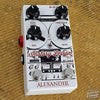My shopping cart
Your cart is currently empty.
Continue Shopping4727 N Damen Ave Chicago, IL 60625 | 773.878.8616 | rocknrollvintage@gmail.com | Showroom Hours: 12-6pm Tuesday-Friday | Saturday 12-5pm (Closed: Sunday/Monday)
Alexander History Lesson Vol 2


Go back to school with your guide to three decades of delay. The History Lesson Vol.II is majoring in Echo with a minor in Modulation.
The History Lesson Vol.II is our loving homage to the best echoes the past has to offer. We’ve updated the pedal with stereo outputs, an improved mixer section, and a tone control for maximum versatility while remaining easy to use. So plug in and turn some knobs with us on our journey through the past.
What's new in Vol. 2?We've made some big changes in the History Lesson Vol. 2. Based on customer suggestions, we've added a tone control to the echo, allowing you to tailor its response to fit perfectly in your mix. We removed the "rubber-band" artifacts while tapping or adjusting the delay time. We've also added a second output that carries the analog dry signal. Finally, we've improved the mixer section to allow you to have fully-wet mix and trails if you want them.
Controls:TIME (Tone) - adjust the delay time from 10ms to 950ms. Turning this knob cancels the Tap Tempo setting. Holding down the Bypass / Tone footswitch lets you adjust the tone of the echo effect. The Tone setting is stored in the memory of the pedal for future use, and it responds differently for each of the modes in the pedal.
REPEAT - controls the feedback of the delay. The 1977 mode will go into infinite / runaway feedback.
MOD - Adds a luscious modulation to the delay. At 12 o’clock there is no modulation. Clockwise adds a slow chorus and counter-clockwise adds a fast vibrato.
MIX - Controls the blend between fully dry (clean) and fully wet (repeat only) echo sound. 12 o’clock is an equal mix of clean and echo.
*Hint: The Mod knob works even when the delay time turned all the way down, allowing the History Lesson to function as an chorus or vibrato pedal. The chorus takes on the "flavor" of the delay machine, so you can get tape / analog / digital chorus or vibrato.
Tap Tempo / Division - tap twice to set the delay time. The LED above the Tap switch flashes to indicate the current tempo and division. Hold this footswitch to toggle between quarter-note (green,) eighth-note (red,) or dotted-eighth (orange) subdivisions. The subdivision setting is stored in the memory of the pedal for future use.
Remote Tap Tempo Jack - connect a standard normally-open momentary switch to this jack to allow for remote tap tempo and subdivision selection. The History Lesson Vol. 2 may also interface with a pedalboard clock source such as a Disaster Area SMARTClock or DMC Gen3.
Mode Toggle:1963 - Magnetic tape echo, warm and rich. The 1963 mode captures the frequency response of the tape heads and preamp of a vintage tape delay. The Mod knob controls the "wow" or "flutter" of the tape. Each delay repeat loses both treble and bass, for a warm and compressed sound. The Tone knob controls the age of the tape, making the echo brighter or darker.
1977 - Analog delay, murky and wet. The 1977 mode is based on a classic solid-state analog echo. This mode is capable of infinite repeats for the classic analog delay "spaceship" tone. The Mod knob adds analog chorus or vibrato. The Tone knob controls the analog delay filter.
1984 - Digital delay, bright and present. The 1984 mode captures the sheen and clarity of the early digital delays. Each repeat sounds just like what you put in, with the classic digital "clang" you will either love or hate. The Mod knob adds wide-ranging pitch modulation, be careful! The Tone control sweeps the delay between low-pass and high-pass filtering for a wide range of delay tones.
Bypass Switching:
The History Lesson Vol. 2 features a buffered bypass with optional "trails." In Trails mode the delay will continue to repeat when the pedal is bypassed. To switch between standard bypass and trails, hold the bypass switch while powering on. The LED will blink once for standard bypass or five times for trails. The pedal remembers the last setting.
Power Supply:
The History Lesson Vol. 2 requires a 9V DC power supply with a 2.1mm pin, center negative. The History Lesson Vol. 2 is not designed to be powered on supplies higher than 9V and does not use a battery. The History Lesson Vol. 2 should work fine on a multi-pedal "daisy chain" connector, but if you encounter excessive noise or hum try a separate power supply. The History Lesson Vol. 2 requires approx. 60mA.